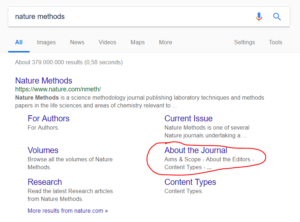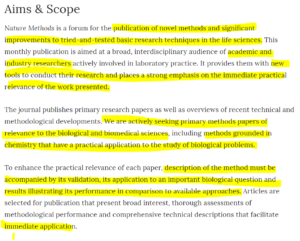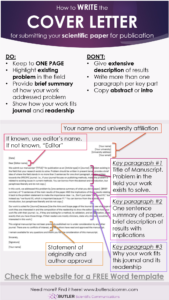There is a lot of great stuff for you in this post on how to write a cover letter for a scientific journal, so if you are skipping around, make sure you don’t miss:
How to write a cover letter for a scientific journal
Your FREE Word template for writing a cover letter
A helpful infogrpahic to visualize the contents of your cover letter
or you can listen to this post in a video format:
Ready to go with the text version? Great – let’s get started!
Recap of previous post
Recapping from our previous post on what not to include in your cover letter, there was a list of items that that your cover letter SHOULD include:
- an indication that you are familiar with the content that the journal typically publishes
- a BRIEF, DIRECT description of where the field stands, as fits the journal (1 paragraph MAX)
- a gap in the field (1 sentence)
- how your research filled that gap (1 paragraph MAX, combined with research conclusions)
- a BRIEF description of your research findings OR relevant techniques used. This is solely to indicate your suitability for their journal and what you write depends on the type of content they are seeking (1 paragraph MAX, combined with paragraph on research design)
- an explanation of exactly why your content fits with the journal (1 paragraph, combined with readership below)
- an explanation of how/why your research will interest the readership of that journal (1 FULL paragraph…yes really.)
Why you shouldn’t let your results speak for themselves when you write a cover letter for a scientific journal
Notice that my above list includes detailed descriptions of how long each section of the cover letter needs to be. Yes, if you follow my suggestions, your cover letter will be about three full paragraphs. No, you absolutely cannot “tweak” the suggestions above and make 2.9 of them about your research and add a stock line that mentions the journal name as a reason why it should be considered for publication.
You know the line:
“We feel that our manuscript will be a good fit for the readership of XXX journal.”
No no no – DON’T write that. Not only does it tell the editor nothing at all, it also makes it seem like you were too lazy to look up any specifics.
At this point, you need to sell your manuscript to the editor, not provide enough details to pass a peer-review, and anything more than a brief and concise summary of your results is way too much.
In fact, the point is to entice the editor to open the manuscript – giving a brief “teaser” is a more effective strategy.
The over-providing of facts without context is a common problem in science. We researchers operate on data points and concrete details, and it feels more “legit” to throw as many facts as possible at someone to help them see your point.
Unfortunately, to someone who has to sort through thousands of article submissions a year to judge which are worthy for inclusion, that often feels like you are handing them this:

Is your editor going to put together that puzzle to see the big picture of your research and how it fits into their journal? Oh, maybe. If they are having a slow day, they might. Or if they haven’t had too many great submissions lately, sure.
But what if they just had a couple FANTASTIC papers accepted? Are they going to be so inclined to assemble your puzzle? What if they are tired that day and don’t feel like putting together a puzzle? What if someone walks into their office and distracts them partway through your puzzle? Are they going to pick it up again?
Would you?
I’m going to guess not.
Don’t let the fate of your manuscript rest on how recently your editor refreshed their coffee before reading your cover letter.
By limiting the space taken by your research to one paragraph, you can still give the editor enough facts to make an informed decision and, more importantly, will have the space to show the editor exactly how your manuscript fits into the puzzle that is their journal’s wants and desires.
So, don’t think of the last suggested paragraph of your cover letter as taking up valuable space you could be using to squeeze in more facts. This paragraph is actually where you are assembling the puzzle for your editor. Instead of giving them the jumble of pieces, your last paragraph is making sure you give them something that looks much more like this:

Isn’t that a much more appealing scenario for your editor?
Ok, so now we know that we want to allow the editor to see the overall picture, but how do we do that in a cover letter? What important things need to be included for this to happen?
How to write a cover letter for a scientific journal
Do your background research
First, you need to know the journal you are applying to and why your paper fits that journal. How do you learn this?
Let’s use Nature Methods as an example journal. First, you should always have some idea about the types of content that a journal publishes based on reading other papers from that journal. To make sure you are as specific as you can, though, when writing your cover letter, first google Nature Methods:

Right on the Google search screen, you can see a section titled “About the Journal”, which will give you the aims and scope of the published journal content. The Aims and Scope section of each journal is your golden ticket, because it tells you in no uncertain terms exactly how to focus your cover letter. From this, you can see exactly what to highlight in your paper based on what the journal is looking for and the points you should make sure stand out to your editor. Have a look:

The highlighted points here are the exact things you want to discuss about your paper.
Use your last paragraph, where you tie your research into the desired journal, to give examples of each of these points to indicate exactly how your research is what the journal is looking for.
Nature Methods is actively looking for new chemical techniques that can enhance biological study. Do you have one of those? If so, make sure you say exactly that in your cover letter.
Do you describe a method, give its validation, and use this method to answer an important biological question? Tell the editor that all of those things are in your paper, and indicate what biological question you answered (hint – if you DIDN’T do that, though, why are you trying for Nature Methods?).
Is your work immediately applicable? If so, highlight that and provide evidence. Would it be useful in industry as well as academia? Tell the editor that and tell them why you can appeal to both audiences.
Obviously it goes without saying that your article does have to fit the journal.
I’m definitely not encouraging you to make up information to make it seem like your article fits.
But even an article that fits a journal can be overlooked by an editor if they cannot immediately see how the puzzle fits together. Your cover letter should show the editor that what you are giving them is exactly what they want so that they don’t have to think about it and possibly overlook something important.
Don’t make them guess! Give them a better picture of your research’s place in their journal than a jumble of puzzle pieces, and you’ll have a more convincing application to their journal.
Put it all together to write your cover letter for a scientific journal
The easiest way to put this altogether is to use my FREE Word template. It has the appropriate headings, needed key lines, and space for each of the paragraphs I am going to describe below.
You cna get this template delivered instantly to your inbox by going here:
Click here for your FREE Word template for writing a cover letter for a scientific journal!
Otherwise, I recommend splitting your cover letter into three key paragraphs:
- Title of your manuscript, type of manuscript (article, communication, etc.), and brief description of the problem in your field that your paper exists to solve.
- Start with a one sentence summary of the paper, including how it addresses the problem or gap mentioned above. Follow this with a brief description of the main findings of the paper and their implications.
- Indicate how this work fits with the aims and scope of the journal and why it would interest the readership of that journal.
If you prefer to see this visually, you can check out this infographic that shows the layout of the cover letter, including the key information for each paragraph (click to enlarge):
And that’s it – all you need to know to write your cover letter for a scientific journal.
Don’t forget to that you can always use the template for a bit more help.
Otherwise, happy writing and let us know how it went in the comments!


